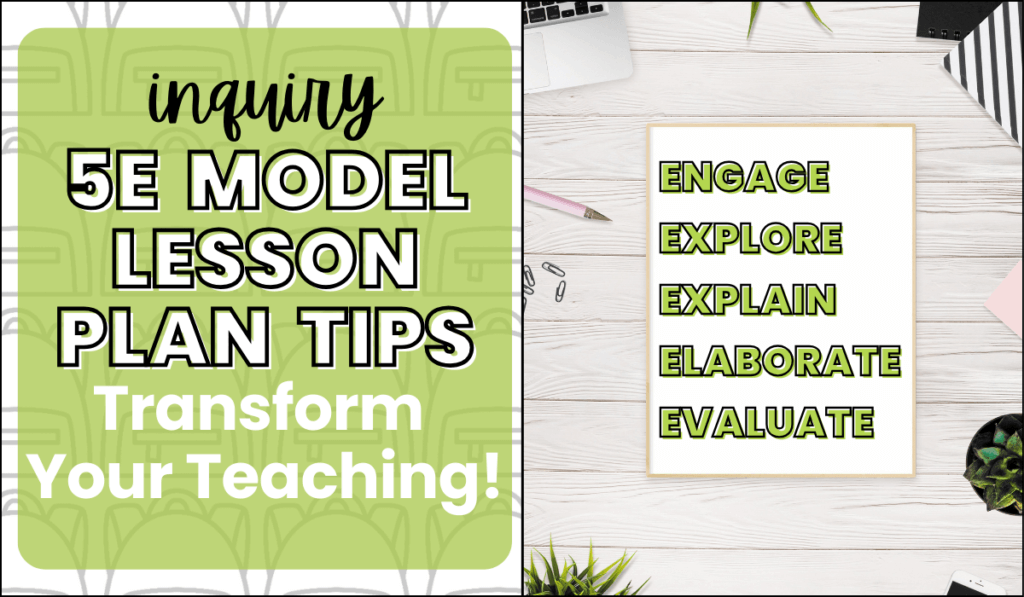

The 5E instructional model lesson plan is a valuable tool for teaching, consisting of 5 phases: Engage, Explore, Explain, Elaborate, and Evaluate. This framework provides a clear structure for designing lessons in any subject that will motivate students and encourage critical thinking through inquiry-based learning.
If you are looking for a way to engage students and encourage active participation in learning, the 5E inquiry model is perfect for you! In this blog post, I’ll guide you step by step through each stage of a 5E model lesson and provide examples of fun activities and resources that will help bring excitement to your classroom.

Engage & Explore: Igniting Students' Curiosity with the 5E Model
The Engage stage is all about sparking inquiry in students’ minds and getting them excited about learning! Picture this: hands-on activities, thought-provoking questions, and interactive experiments. For example, you might kick off a lesson by asking a fascinating question, presenting a problem that students aren’t able to solve yet, showing pictures or a short video, or conducting a demonstration.
Then, in the Explore stage, students will dive deeper into the topic through exploratory activities and investigations. The goal of this phase is to make connections between prior knowledge and new information through guided activities. You should allow students time to share their observations and work together. Think group discussions, experiments, and interactive simulations!
Unraveling Concepts to Empower Student Learning: Explain & Elaborate
In the Explain phase, you’ll guide your students through the process of breaking down complex concepts. You may use visual aids, graphic organizers, diagrams, models, or even real-world examples to clarify the concept and help students organize their thoughts.
Then, the Elaborate phase allows students to apply their new knowledge to solve problems, conduct experiments, or engage in creative projects. Students will gain a deeper understanding of what they’ve learned by connecting the topic to the real world.


Evaluate: Assessing Learning Effectively with the 5E Model
Every good lesson plan includes a method to determine if the lesson objectives have been met. In the Evaluate stage, you’ll check student understanding through quizzes, tests, rubrics, or other forms of assessment. You can also differentiate by providing scaffolds or using different types of assessments based on the needs of your students.
I also like to incorporate a secret 6th “E” to my 5E model lesson plans: Extend! Here’s where you can take learning to the next level. While this is completely optional, you may discover that your students are particularly fascinated by a certain topic and wish to explore it further! Whether through a research project, a hands-on experiment, or a presentation, the Extend stage allows students to showcase their expertise.
My Favorite 5E Model Lesson Plan Examples: Engaging Resources & Activities!
Ready to discover some fantastic 5E lesson plans? Look no further! In my TPT store, you’ll find several resources to enhance your teaching. From math to science, there’s something for everyone. Explore the links and blog posts mentioned below for more details!
- Greedy Triangle Math 5E Lesson Plan – check out my blog post about this awesome lesson HERE!
- Magnet Madness! Science 5E Lesson Plan
- Earth, Sun, & Moon Science 5E Lesson Plan – check out my blog about this resource HERE!
- Math Curse 5E Model Math Mini-Unit: 5 Days of Engaging Lessons & Activities!
- Renewable vs. Nonrenewable Resources Science 5E Lesson
- Weather Watchers Graphing Science & Math 5E Unit – this product is mentioned in my bar graphing blog post HERE.

Create Engaging Experiences with 5E Model Lessons!
From igniting curiosity to assessing learning and extending student engagement, the 5E model is a game-changer in education. Try the 5E Model in your classroom, and watch your students be captivated and excited to learn and discover new concepts!
What questions do you still have about the 5E Model? Leave a comment below!
If you’d like to save these ideas for later on Pinterest, pin the images below.





